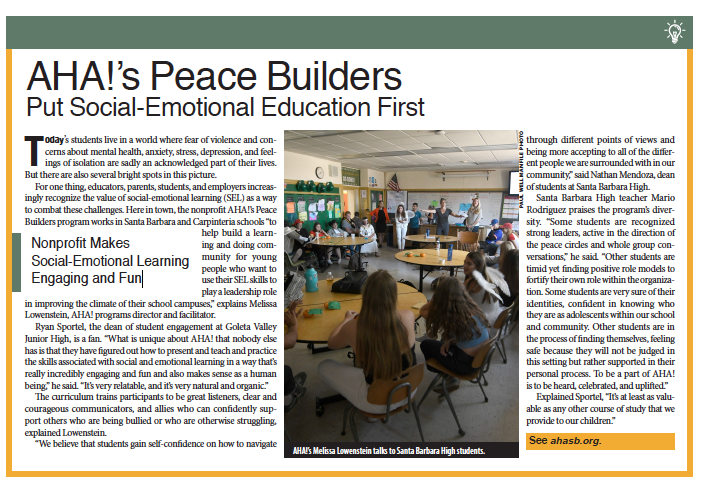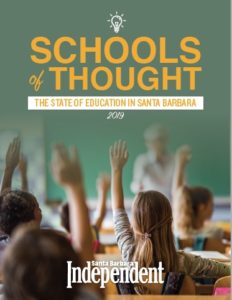
AHA’s Peace Builders From Schools of Thought, Santa Barbara Independent, November 7, 2019.
Nonprofit Makes Social-Emotional Learning Engaging and Fun
Today’s students live in a world where fear of violence and concerns about mental health, anxiety, stress, depression, and feelings of isolation are sadly an acknowledged part of their lives. But there are also several bright spots in this picture.
For one thing, educators, parents, students, and employers increasingly recognize the value of social-emotional learning (SEL) as a way to combat these challenges. Here in town, the nonprofit AHA!’s Peace Builders program works in Santa Barbara and Carpinteria schools “to help build a learning and doing community for young people who want to use their SEL skills to play a leadership role in improving the climate of their school campuses,” explains Melissa Lowenstein, AHA! programs director and facilitator.
Ryan Sportel, the dean of student engagement at Goleta Valley Junior High, is a fan. “What is unique about AHA! that nobody else has is that they have figured out how to present and teach and practice the skills associated with social and emotional learning in a way that’s really incredibly engaging and fun and also makes sense as a human being,” he said. “It’s very relatable, and it’s very natural and organic.”
The curriculum trains participants to be great listeners, clear and courageous communicators, and allies who can confidently support others who are being bullied or who are otherwise struggling, explained Lowenstein.
“We believe that students gain self-confidence on how to navigate through different points of views and being more accepting to all of the different people we are surrounded with in our community,” said Nathan Mendoza, dean of students at Santa Barbara High.
Santa Barbara High teacher Mario Rodriguez praises the program’s diversity. “Some students are recognized strong leaders, active in the direction of the peace circles and whole group conversations,” he said. “Other students are timid yet finding positive role models to fortify their own role within the organization. Some students are very sure of their identities, confident in knowing who they are as adolescents within our school and community. Other students are in the process of finding themselves, feeling safe because they will not be judged in this setting but rather supported in their personal process. To be a part of AHA! is to be heard, celebrated, and uplifted.”
Explained Sportel, “It’s at least as valuable as any other course of study that we provide to our children.”
 Click here to read this story as it originally appeared in the Santa Barbara Independent on November 7, 2019. SB Independent Schools of Thought Insert 11.7.19
Click here to read this story as it originally appeared in the Santa Barbara Independent on November 7, 2019. SB Independent Schools of Thought Insert 11.7.19


 Basically, the San Jose model outlined ten goals for ten years. Number one was to support the resident’s personal participation in arts and culture. Number two: to support availability of diverse cultural spaces and places throughout the community. Number three was to strengthen downtown San Jose as the creative and cultural center of the region. Number four: integrate public art and urban design throughout the community. Number five: expand residents’ access. Number six was to foster destination quality events in San Jose. Number seven: strengthen marketing and engagement. Number eight was to enhance support for creative entrepreneurs and the commercial creative sector. Number nine, to strengthen the cultural community’s infrastructure. And finally, number ten, to increase funding.
Basically, the San Jose model outlined ten goals for ten years. Number one was to support the resident’s personal participation in arts and culture. Number two: to support availability of diverse cultural spaces and places throughout the community. Number three was to strengthen downtown San Jose as the creative and cultural center of the region. Number four: integrate public art and urban design throughout the community. Number five: expand residents’ access. Number six was to foster destination quality events in San Jose. Number seven: strengthen marketing and engagement. Number eight was to enhance support for creative entrepreneurs and the commercial creative sector. Number nine, to strengthen the cultural community’s infrastructure. And finally, number ten, to increase funding.